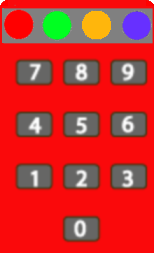Skip over navigation

Send us your solution for a number which will turn on all the lights, with an explanation of how you arrived at your answer.



Or search by topic
Number and algebra
Geometry and measure
Probability and statistics
Working mathematically
Advanced mathematics
For younger learners
Four Coloured Lights
Age 11 to 14
Challenge Level 






Imagine a machine with
four coloured lights and a keypad for entering numbers.
Each light responds to a
different rule. When a number is typed in, lights go on if their
rule is satisfied. If the number satisfies more than one rule, then
more than one colour will light up.
Your challenge is to find
the smallest possible number which will make all four colours light
up.
Here are some
data which have been collected about the responses from the
machine. Try to make sense of the information and figure out the
rules used by the machine.
A second machine works in
the same way but according to a different set of rules. Here are the
data from the second machine.
Send us your solution for a number which will turn on all the lights, with an explanation of how you arrived at your answer.
You may also like
Summing Consecutive Numbers
15 = 7 + 8 and 10 = 1 + 2 + 3 + 4. Can you say which numbers can be expressed as the sum of two or more consecutive integers?
Where Can We Visit?
Charlie and Abi put a counter on 42. They wondered if they could visit all the other numbers on their 1-100 board, moving the counter using just these two operations: x2 and -5. What do you think?
Tilted Squares
It's easy to work out the areas of most squares that we meet, but what if they were tilted?

